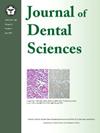3d打印义齿基托树脂表面特性对生物反应和生物膜形成的影响:体外研究
IF 3.1
3区 医学
Q1 DENTISTRY, ORAL SURGERY & MEDICINE
引用次数: 0
摘要
背景/目的随着数字技术的进步,使用3d打印义齿基托树脂(DBR)制造全口义齿的全数字化工作流程近年来得到了越来越多的临床接受。然而,3d打印DBR材料的表面特性、生物相容性和生物膜形成仍然没有得到充分的了解。因此,在本研究中,我们对这些方面进行了调查和分析。材料和方法采用填充(PA)、铣削(ML)和3D打印(3D)工艺制备盘状DBR样品(Ø 2.5 mm, 3mm厚)。所有的样品都用碳化硅砂纸(#600)研磨,并用超声波清洗。利用扫描电子显微镜和原子力显微镜分析了表面微观形貌和亚微米粗糙度,并用角计测量了接触角,计算了表面能。在标本上培养人牙龈成纤维细胞和放线菌聚集菌,观察其细胞毒性和生物膜形成情况。采用显著性水平0.05进行统计学分析。结果显微成像显示,3D组的纹理分布更加均匀,表面粗糙度最低(0.85 μm)。此外,PA基团具有最疏水的表面(82.47°)和最高的表面自由能(46.08 mN/m)。值得注意的是,72h后各组均未出现细胞毒性作用。此外,3D组在微生物培养24 h和72 h后的生物膜形成最低。结论3d打印DBRs表面粗糙度最低,保持无细胞毒性,具有良好的抗微生物粘附能力,具有制作全口义齿的潜力,易于维持口腔卫生,具有长期临床应用价值。本文章由计算机程序翻译,如有差异,请以英文原文为准。
Impacts of surface characteristics on biological responses and biofilm formation of 3D-printed denture base resins: An in vitro study
Background/purpose
With advancements in digital technology, fully digital workflow for complete denture fabrication using 3D-printed denture base resin (DBR) has gained increasing clinical acceptance in recent years. However, the surface characteristics, biocompatibility, and biofilm formation of 3D-printed DBR materials remain insufficiently understood. Therefore, in this study, we investigated and analyzed these aspects.
Materials and methods
Disk-shaped DBR specimens (Ø 2.5 mm, 3 mm thick) were fabricated using packed (PA), milled (ML), and 3D-printed (3D) processes. All specimens were ground with silicon carbide sandpaper (#600) and ultrasonically cleaned. Surface microtopography and sub-micron roughness were analyzed using scanning electron microscopy and atomic force microscopy, while a goniometer was used to measure contact angles to calculate the surface energy. Human gingival fibroblasts and Aggregatibacter actinomycetemcomitans were cultured on the specimens to assess the cytotoxicity and biofilm formation. Statistical analyses were performed with a significance level set to 0.05.
Results
Microscopic imaging revealed that the 3D group exhibited a more uniformly distributed texture, while it also had the lowest surface roughness (0.85 μm). Additionally, the PA group had the most hydrophobic surface (82.47°) and the highest surface free energy (46.08 mN/m). Notably, no group showed cytotoxic effects after 72 h of testing. In addition, the 3D group demonstrated the lowest biofilm formation after both 24 h and 72 h of microbial culture.
Conclusion
3D-printed DBRs exhibited the lowest surface roughness, maintaining non-cytotoxic and superior resistance to microbial adhesion, suggesting their potential for complete denture fabrication, easy maintenance of oral hygiene, and long-term clinical performance.
求助全文
通过发布文献求助,成功后即可免费获取论文全文。
去求助
来源期刊

Journal of Dental Sciences
医学-牙科与口腔外科
CiteScore
5.10
自引率
14.30%
发文量
348
审稿时长
6 days
期刊介绍:
he Journal of Dental Sciences (JDS), published quarterly, is the official and open access publication of the Association for Dental Sciences of the Republic of China (ADS-ROC). The precedent journal of the JDS is the Chinese Dental Journal (CDJ) which had already been covered by MEDLINE in 1988. As the CDJ continued to prove its importance in the region, the ADS-ROC decided to move to the international community by publishing an English journal. Hence, the birth of the JDS in 2006. The JDS is indexed in the SCI Expanded since 2008. It is also indexed in Scopus, and EMCare, ScienceDirect, SIIC Data Bases.
The topics covered by the JDS include all fields of basic and clinical dentistry. Some manuscripts focusing on the study of certain endemic diseases such as dental caries and periodontal diseases in particular regions of any country as well as oral pre-cancers, oral cancers, and oral submucous fibrosis related to betel nut chewing habit are also considered for publication. Besides, the JDS also publishes articles about the efficacy of a new treatment modality on oral verrucous hyperplasia or early oral squamous cell carcinoma.
 求助内容:
求助内容: 应助结果提醒方式:
应助结果提醒方式:


